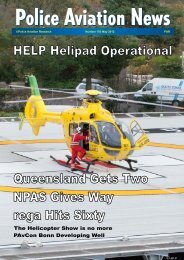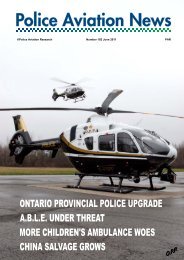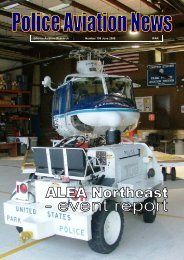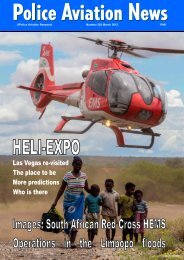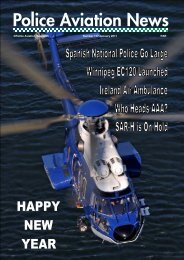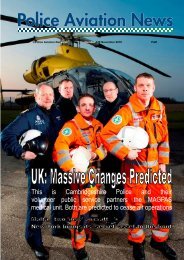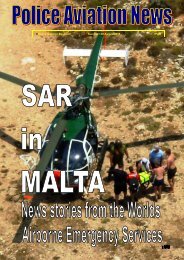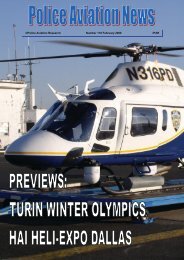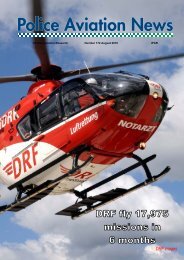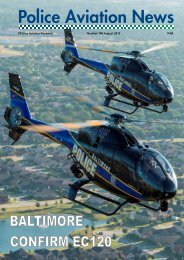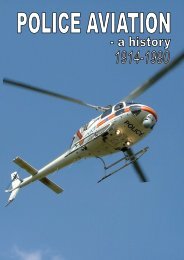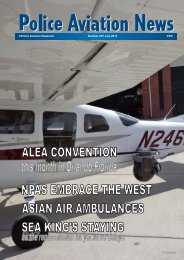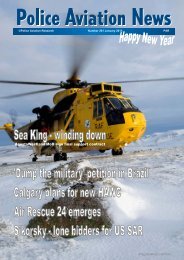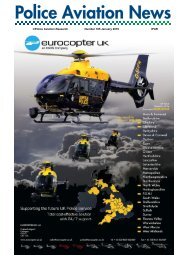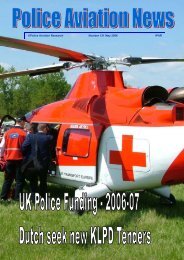Police Aviation News April 2011
Police Aviation News April 2011
Police Aviation News April 2011
Create successful ePaper yourself
Turn your PDF publications into a flip-book with our unique Google optimized e-Paper software.
<strong>Police</strong> <strong>Aviation</strong> <strong>News</strong> <strong>April</strong> <strong>2011</strong> 28<br />
FEATURE<br />
Lets do ‘NVG’…… (Night Vision Goggles)<br />
A great idea but there are hidden implications.<br />
You don’t have to go particularly far in a public sector helicopter community before you hear<br />
‘NVG’ in the conversation. Operating helicopters at night in those really dark rural areas is<br />
far from easy and the introduction of NVG in suitably equipped helicopters can address<br />
some of the operational issues.<br />
The first implication of ‘going’ NVG is that the helicopter cockpit and possibly cabin and external<br />
lighting scheme will need to be made NVG friendly. Cockpit conversion has been going<br />
on for a long time and it is interesting to note that today’s modern glass-cockpits often<br />
embody a significant element of NVG compatibility already when the aircraft are delivered<br />
from the factory. The more difficult issue may be the conversion or upgrading of some of the<br />
other displays and equipment in the aircraft often essential to the mission but not specified<br />
as NVG-compatible when the aircraft was outfitted.<br />
So where is the problem? The issues with NVG as far as the helicopter are concerned start<br />
with certification. Will the regulatory body that oversees your operation agree that your lighting<br />
modifications are compatible with your chosen NVG goggles? What equipment will they<br />
regard as essential for NVG operation and what implications will the failure of NVG lighting<br />
even in part have on your NVG operational capability?<br />
It’s fairly likely that a minimum equipment list for NVG will be needed…. But it is also possible<br />
that any equipment that cannot operate in its NVG mode – with the correct lighting – will<br />
invalidate the NVG clearance completely. White un-filtered light can and does have a horrible<br />
effect on NVGs themselves and its possible or highly likely that any white light emissions<br />
will make NVG difficult or even impossible.<br />
In short for an NVG solution to work, all the equipment embraced in the NVG lighting solution<br />
needs to work in an NVG mode. A radio control-head may be fully functional but the<br />
NVG lighting has failed. The head’s screen is visible under white light. One item’s lighting<br />
capability can close down in entirety the NVG compatibility of a cockpit and the NVG capability<br />
of an operation. Equipment lighting in regular night flying is important but in most<br />
cases it hardly crucial to safe operation. With NVG this is not the case.<br />
So what are the other implications? By going down the NVG route, you will have already<br />
noted the need for end-user certification for the goggles but until the equipment in the cockpit<br />
fails you may not have noticed that the pesky little NVG part numbers may also be enduser<br />
controlled. What may be worse or harder to manage is that the equipment with ‘-NVG’<br />
at the end of the part number may be very short supply indeed. Equipment which fails<br />
through lighting, or any other defect will need to be repaired but may find itself in a long repair<br />
pipeline.<br />
A quick glance into the cockpit will reveal that keeping an NVG-compatible cockpit ‘NVG<br />
compatible’ could be a challenge. The number of boxes and lights is significant and you<br />
might also want to look at the replacement and repair costs for the more specialised –NVG<br />
parts. The very worst will be items subject that have been subject of custom conversion by<br />
third parties where the act of conversion itself may (probably will) have invalidated any OEM<br />
warranties.<br />
The point I make is simple. NVG operations may add hugely to a unit’s capabilities but<br />
when looking ahead at sustaining this, even for a short time, make sure you have discussed<br />
the provision of repair services and those pesky little end-user certificates if you hope to<br />
avoid extended lack of NVG capability when kit goes wrong and explaining to those who<br />
don’t understand aviation why your NVGs can’t be used. The conversion and goggles will<br />
have been a sizeable investment and keeping the kit working will cost more than before.<br />
What is odd here is that there was once a very simple NVG conversion scheme that worked<br />
in many cases. NVG filtered floodlights were installed to illuminate the instrument panel.



